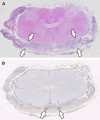Feline coronavirus in multicat environments
- PMID: 22041208
- PMCID: PMC7111326
- DOI: 10.1016/j.cvsm.2011.08.004
Feline coronavirus in multicat environments
Abstract
Feline infectious peritonitis (FIP), a fatal disease in cats worldwide, is caused by FCoV infection, which commonly occurs in multicat environments. The enteric FCoV, referred to as feline enteric virus (FECV), is considered a mostly benign biotype infecting the gut, whereas the FIP virus biotype is considered the highly pathogenic etiologic agent for FIP. Current laboratory tests are unable to distinguish between virus biotypes of FCoV. FECV is highly contagious and easily spreads in multicat environments; therefore, the challenges to animal shelters are tremendous. This review summarizes interdisciplinary current knowledge in regard to virology, immunology, pathology, diagnostics, and treatment options in the context of multicat environments.
Figures













References
-
- Rohrbach B.W., Legendre A.M., Baldwin C.A., et al. Epidemiology of feline infectious peritonitis among cats examined at veterinary medical teaching hospitals. J Am Vet Med Assoc. 2001;218(7):1111–1115. - PubMed
-
- Cave T.A., Thompson H., Reid S.W., et al. Kitten mortality in the United Kingdom: a retrospective analysis of 274 histopathological examinations (1986 to 2000) Vet Rec. 2002;151(17):497–501. - PubMed
-
- Garwes D.J. Transmissible gastroenteritis. Vet Rec. 1988;122(19):462–463. - PubMed
Publication types
MeSH terms
LinkOut - more resources
Full Text Sources
Medical
Miscellaneous

